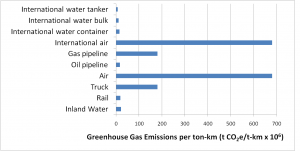by: Julianne Boulton
Reducing your food miles and eating locally can help you to reduce your carbon footprint. See here for steps that you can take to reduce your food miles. Like with any generalisation some food products where food miles may not be as important in choosing the most sustainable source of that product. The method of transport, the seasonality of the product, production energy efficiency all need to be considered when deciding if locally produced results in less carbon emissions than imported.
How your food travels might be more important than how far your food travels. The chart below shows just how variable carbon emissions can for a single kilometre using different modes of transportation. (Data is taken from Weber & Matthews, 2008. A ton-km is the movement of 1 metric ton of cargo over 1 km). It shows that transport by air is considerable higher than transport by water, while transport by land is higher than by water, but still produces much lower emissions than transport by air. Therefore food transported in shorter distances by air or land may produce more carbon emissions than food transported by sea for longer distances.

The year-round demand for fruits and vegetables create a large problem as most fruits and vegetables can naturally be harvested only within a particular season. The three possible solutions to this problem are storage for distribution and use when the items are not in season, growing them under green house conditions or transporting them from other geographical areas where they are in season. Most of the time growing them under greenhouse conditions tends to be the most energy intensive option. Carlsson (1998) shows that in the case of tomatoes for Sweden, locally produced tomatoes require ten times more the energy input than tomatoes imported from Southern Europe. On the other hand, storage can result in an overall high level of energy loss due to the loss of yield while in storage. Therefore sometimes transportation from countries where the fruit and vegetable grow easier may be the most energy efficient option. Of course you can always choose the even better option of only eating seasonally.
Even when a certain product is easily produced locally, importing the product from another country that produces the same product in a much more energy efficient manner may outweigh any additional transportation energy expenditures. An ideal example of this is milk solids produced locally in the United Kingdom versus those imported from New Zealand. The locally produced milk solids result in a 34% higher value carbon emissions. Therefore considering the energy difference of production may be more important than the energy difference in transportation for meat and dairy products. This is because transportation accounts for only about 10% of total carbon emissions of products such as red meat, but up to around 50% of many fruits and vegetables.
